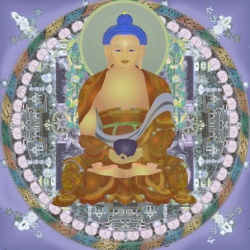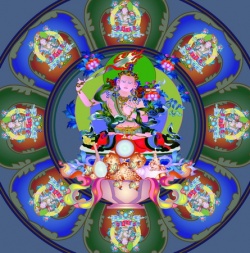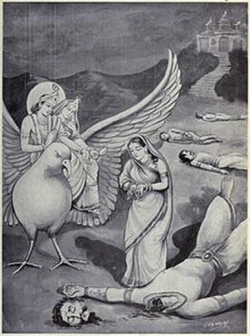The doctrine of the two truths: emptiness and interdependency
"We reply that here you have not experienced the purpose in openness [= sunyata: emptiness), and thus the use of openness is severed from openness by you. The instruction of the teachings of the buddhas are based on two truths [= satya): the truth of common sense conventions about the world [= samvrti-satya and truth in the higher sense of the word [= paramartha-satya). Those who do not understand the distinction between the two truths do not understand the profound reality in the teaching of the Buddha. Higher truth of sunyata is not taught independently of common practice. Liberation is not accomplished by the unattainable higher truth." --Nagarjuna, MK 24:7-10 (in McCagney 1997 200-201)
Terminology
Samvrti --the conventional or relative truth (satya) of the interdependency (pratityasamutpada) of our daily lives; it is also translated as phenomenal existence, worldly convention, worldly reality, worldly norms, and conditioned or mundane truth.
Pratityasamutpada -- the Buddhist causal law of the INTERDEPENDENCY of all things (= dharmas: factors of experience--people, objects, events, ideas). Paramartha -- the highest (ultimate) or supreme truth (satya) of emptiness (sunyata: openness). Sunyata -- Generally translated as emptiness, sunyata refers to the lack of self-nature (svabhava) which we impose on dharmas (= factors of experience: people, objects, events, ideas). Empty (sunya) of our preconceptions, both the perceived dharma and the perceiver are OPEN to mutual relationship.
Svabhava -- the illusion of a permanent (fixed, unchangeable) and independent self-nature or own-being or self-existence opposed to other-nature (parabhava). Svabhava involves the reification of our conceptions which promote attachment to them. The svabhava fallacy is behind all human conflicts historically and worldwide.
On the Buddha's Use of the Two Truths
[Editor's note: In the following quotes, some parenthetical notes in the original texts have been omitted; for consistency, Sanskrit terms replace any Pali terms used in the original texts.] "In [an early scripture (sutra)], the Buddha condemned any attempt to uphold a view as the ultimate. Refusing to recognize any knowledge of 'things as they really are,' and making a more sober claim to knowledge of 'things as they have come to be', the Buddha was reluctant to accept any notion of [[[paramartha]]) as 'ultimate reality'. Instead, he claimed to know 'the dependently arisen' and, on that basis, formulated the conception of 'dependent arising' [= pratityasamutpada).
In such a context, it was more meaningful for him to speak of [[[artha]] (= fruit, effect, purpose, meaning)] and [[[paramartha]] (= ultimate fruit, etc.)] in the sense of fruit, consequence, or result [[[phala]]). Thus, a good action is one that is fruitful and a bad, unfruitful. The Buddha also recognized that views about good and bad, purity and impurity, are in most cases relative conventions. According to the same text, good and bad are conventions that vary depending upon contexts. These are the ways of the world (loka), often characterized as [[[samvrti]]).... However, there is no indication that, since these are relative conventions, the Buddha advocated the transcendence of both good and bad.
Having defined the good as the fruitful, the Buddha characterized the ultimate good as the ultimately fruitful. The term [[[paramartha]]) was thus used to refer to the 'ultimate fruit' rather than 'ultimate reality.' Samvrti and paramartha) are therefore not two contrasting truths. The former is a mixed bag, while the later represents the ultimate ideal. As a result of attaining [[[nirvana]]), which is the complete eradication of lust, hatred, and confusion, the Buddha found himself enjoying an ultimate fruit, without hurting himself or others. [[[Paramartha]]) thus becomes the moral ideal as reflected in the Buddha's own attainment of freedom and happiness." (Kalupahana 1986 331-332)
The two truths address the human tendency to absolutize conceptualizations, which are only maps and not the territory--when absolutized, our concepts conceal the territory and obstruct our view of it. Thus, as Kalupahana says, "there is no indication that, since these are relative conventions, the Buddha advocated the transcendence of both good and bad." Regarding the conventional (samvrti) daily life, to transcend dualisms such as good and bad through some absolute nondualism simply reestablishes a dual new pair between dualism and nondualism. This misconceived transcendence also negates the path to freedom from reified dualisms and attachment to them.
This same error occurs when a reified emptiness was used by an opponent to reject Madhyamika's view of sunyata (emptiness) as nihilistically denying the three jewels, the Buddha, the Sangha (spiritual community), and the Dharma. (see MK 24:1-6 in McCagney 1997 199-200) When such a transcendence is reified as an absolute nondualism it violates the two truths, as seen in today's popular Buddhism through its "all is relative" dogma which promotes, with its abusive conversion tactics, a transmoralism with its own moral agenda. Thus, ultimately the “worldly norms” are not violated but remain intact.
"The worldly norms are not violated but in reality [the Tathagata (Buddha)] has expressed no teachings about his principles. Being ignorant about what the Tathagata states [fools] are consequently afraid of this spotless preaching. The worldly principle that ‘this arises depending upon that’ is not violated. But since that which is dependent lacks own-being (svabhava), how can it exist [[[Wikipedia:independently|independently]] (by own-being (svabhava)” --Nagarjuna’s SS 70-71 (in Lindtner 1982 67)
Emptiness (sunyata: openness) leads us to nonattachment to our views (maps). Interdependency emphasizes the relationships within our daily lives where choices (is/is not) are necessary--but devoid of attachment. As Aryadeva says (CS 8:17; see below), the Buddha’s Dharma teaches nonattachment. Attachment to an amoral or transmoral view which transcends both good and evil is just as distorted as the attachment to a rigid morality. The Madhyamaka's middle path and two truths address these errors so that the notion of absolutes is thoroughly deconstructed. On Nagarjuna's Use of the Two Truths (in MK 24:7-10)
"In his considered and acute reply in [MK 24], Nagarjuna sets out several of the key principles of the Madhyamaka. To begin with, it is observed that an opponent who [asserts that sunyata (emptiness) negates the Dharma) merely reveals his own ignorance of the sense of emptiness (sunyata). One must first distinguish between the two levels to which the Buddha's teachings relate: the 'worldly surface truth' [= samvrti and truth as ultimate reality [= paramartha); for the person who cannot distinguish between them simply does not understand the deep reality [[[tattva]]) of the teaching.
Now, there can be no communication of ultimate reality (paramartha) without resorting to [common practice (vyavahara)]; and without comprehending the paramartha, nirvana is not to be attained.... In the Madhyamaka the word sunyata is used as a term for origination in dependency (pratityasamutpada), and it is a conditional (pragmatic) designation; this is the middle way (pratipat madhyama), which falls neither into annihilationism [= IS NOT] by denying what originates in dependence, nor into eternalism [= IS] by hypostatizing [= conceptual reification) as real what are constructs and designations originating in dependence and, consequently, empty of own being [= svabhava)." (Ruegg 1981 16-17) On the Consistency Between Buddha and Nagarjuna
"The passages above on the truth of both samvrtisatya and paramarthasatya from the Pali commentaries and from Nagarjuna raise the question as to whether these are two levels of truth. The paramarthasatya is not more true than samvrtisatya, it is simply truth of a wider domain. Samvrtisatya is a true description of the world (loka) and of the Buddhist teachings, paramarthasatya is a true description of the descriptions of world and of the Buddhist teachings. Paramarthasatya derives from 'parama' (higher) and connotes a broader range. [It is argued] that paramarthasatya is a meta-language, a language about language, but this is unlikely. Paramarthasatya is simply a caveat [= warning] about samvrti expressed on the same, not a higher, 'level.'
In sum, Nagarjuna is consistent with Gautama [= Buddha) on the meaning and salvific role of pratitya samutpada [= interdependency], but unique in his definition of sunyata as pratitya samutpada. However, this latter move is fully consistent with the Theravada [= early school of the Elders) commentarial tradition on a distinction between two truths. Nagarjuna defines pratitya samutpada as sunyata (open-endedness) and thus a higher truth (paramarthasatya) is events are not arising and not ceasing, not permanent and not impermanent, not identical and not different, not coming and not going.
Because pratitya samutpada is open (sunya), it works or functions as Gautama taught. The conventional truth (samvrtisatya) is that pratitya samutpada arises and ceases (is impermanent) and the Tathagata [= Buddha) has come and gone. In sum, paramarthasatya is dependent on samvrtisatya which teaches the path to nirvana for the extinction of suffering.... That is, nirvana cannot be attained without samvrtisatya. The higher truth is that nirvana and paramarthasatya are open (sunya) and so are unattainable. Attainment, the one who attains and the path to attainment are open-ended and so indistinguishable. Thus paramarthasatya, who or what is it that could be said to arise or pass away?" (McCagney 86-87; and compare Kalupahana 1986 69)
THE RELATIONSHIP BETWEEN THE TWO TRUTHS
"In brief, the Tathagatas [= Buddhas) explain nonviolence (ahimsa) as virtuous behavior and nirvana as, in fact emptiness (sunyata). Here [in our system] there are only these two."
--Aryadeva, CS 12:23 (in Lang 1986 117)
"The Tathagatas [= Buddhas) recommend attachment to virtuous behavior to those who desire heaven. They do not recommend that same [[[attachment]]) to those who seek liberation. How much more so [[[attachment]]) to something else!" --Aryadeva, CS 8:17 (in Lang 1986 85) "There is no distinction whatever between samsara and nirvana. There is no distinction whatever between nirvana and samsara. The limit of nirvana is that of samsara. The subtlest difference is not found between the two." --Nagarjuna, MK 25:19-20 (in McCagney 1997 209) "When one affirms 'being' there is a seizing of awful and vicious dogmas which arise from desire and hatred, and from that contentions arise. That is the cause of all dogmas, without it the passions do not arise. So when this is thoroughly understood, dogmas and passions disappear.
But how is it thoroughly known? By seeing dependent origination! The [[[Buddha]]) best among knowers of reality (tattva) also said that that which is dependently born is unborn [= empty). For those who, suppressed by false knowledge, take the untrue for true, a series of seizing and contention [and so on] will arise. The magnanimous [= Buddhas) have neither thesis nor contention. How can there be an opposing thesis to those who have no thesis?" --Nagarjuna, YS 46-50 (in Lindtner, Chr. 1982. Nagarjuniana: Studies in the Writings and Philosophy of Nagarjuna. Delhi: Motilal Banarsidass, pp. 115)
As stated elsewhere, there is clear genius in the relationship between the two truths. First, they are mutually defining: to see a dharma's emptiness (sunyata: the lack of svabhava) is to know its interdependency (pratityasamutpada: the openness to relationship) and vice versa. Also, the relationship between the two truths is a practical model for the relationship between any two dharmas (such as self/other), in the sense that they are empty of svabhava, interdependent, and thus mutually defining. So, the two truths apply equally to themselves and to all dharmas.
By mutual definition, attempts to absolutize or reify (= to make real) either truth automatically invokes the other to neuter it. To realize one of the two truths is to understand the other. A dharma empty of svabhava is interdependent (= open and not hindered by our preconceptions) and vice versa. There is no interdependence without emptiness and vice versa. As dharmas (ideas) themselves, the two truths are both empty (sunya) of svabhava (self-nature) and interdependent on relational (contextual) influence. So, emptiness is interdependent (dependently arisen) and interdependency is also empty of self-nature. Thus, framing the two truths in terms of their relationship resolves the TENDENCY to absolutize either of the two truths: interdependency or emptiness.
To reify either one splits them from their mutually defining context and thereby distorts their purpose. For more on this important issue, see THE EGROUP email postings on "Dynamics of the middle path" (#50-52 from 02-03-02 to 04-02-02), and on "The two truths versus Derridean deconstruction" (#67 of 08-01-02). The Interdependency of Daily Life (Samvrti: Conventional Truth) "If [no] characteristic is present [= in the mind by mental reification and attachment), the characterized does not occur. If there is no occurrence of the characterized, there is no occurrence of the characteristic. Therefore the characterized does not occur nor does the characteristic occur. Separate from the characteristic and the characterized, no existent occurs." --Nagarjuna, MK 5:4-5 (in McCagney 1997 148-149)
Conscious of it or not, we all use "maps" to guide us as we negotiate our world daily. The Buddha's causal law of interdependency (pratityasamutpada) serves as the best "map" available to us today. This assertion of pratityasamutpada's superiority as a causal explanation is based on several factors, including the important fact that realizing the interdependency of our world brings the wisdom that our perceptions are relative to us and NOT inherent to the perceived dharma. This reminds us of our responsibility for our own views and the actions resulting from them. The belief that what characteristics we see in someone else is their actual inherent nature reflects the svabhava fallacy that dharmas (= factors of experience: people, objects, events, ideas) have a permanent (fixed, unchangeable), independent self-nature (svabhava).
With svabhava, dharmas are permanent, independent, and nonrelational. Within the conventional (samvrti) truth, a belief in the svabhava illusion has several insidious consequences. First, and most importantly, through the svabhava illusion, we mistake the map for the territory in our daily lives. This mental action is called "reification" (= to make real), which means that we rigidify or harden our views about dharmas--for example, we make objects out of people--and thereby assume that our views are correct and that what we perceive actually exists--separate and independent of us--as the real and inherent self-nature of the perceived dharma. Reification also leads to dogma, political, religious, and ideological. Again, by reifying our perceptions of other people, we deny the fact that our views are relative to us and NOT inherent to them. And, when we act upon our preconceptions, relational errors occur, as Nagarjuna says above (YS 46-50).
Second, svabhava promotes the self/other split which is characteristic of all human conflicts historically and worldwide. This is true because, by definition, self-nature (svabhava) is mutually defined by other-nature (parabhava). We can test the truth of this assertion by simply trying to define or describe another person without including our own viewpoint, as the perceiver, in the equation. Perceptions of another person are only valid within the context of the perceiver/perceived relationship. We cannot define another person without including ourselves. On self/other, see Nagarjuna's MK 1:3; MK 15:3-4, 6; MK 22:2-4 (in McCagney 1997 138, 171- 172,192-193)
Third, when svabhava is asserted, and the notion of a permanent, independent "self" separate from other is reified (= to make real), we then experience the tyranny (fear, desire, grasping) of the illusory self as it protects itself, its territory, and its beliefs. So, by seeing how "territory" and "possessions" at the individual level of the self are rooted in the svabhava fallacy, we can understand how svabhava is equally applicable at the national and international levels where human conflicts over territory and beliefs occur historically and worldwide. (See how svabhava impacts our daily lives in Loy 1999 and Lusthaus 1995, as critiqued in the .pdf file “A Modern View of Nagarjuna's Intent and Meaning” on our Current Features webpage.) The Emptiness of Svabhava (Paramartha: Supreme Truth)
The important point is that no dharma can be interdependent WITH svabhava, since svabhava is defined as permanent, independent, and nonrelational. Thus, the supreme (paramartha) truth of emptiness (sunyata) reminds us that all dharmas are indeterminate and unfindable in any final or absolute sense. This awareness promotes NONATTACHMENT to our concepts in our daily lives. We can also cultivate nonattachment by following the NONCOMMITTAL view of The Middle Path between dual extremes (like is/is not).
Therefore, the svabhava illusion leads to dualistic opposition, splitting dharma from dharma, self from other, and so on. Thus, we live by attachment and our interdependency is experienced as the samsaric cycle of birth/death. Without svabhava, we live by nonattachment and experience our interdependency as nirvanic freedom from the tyrannical (fear, desire, grasping) self. The Buddha offered the doctrine of interdependency to expose and eliminate the svabhava fallacy which is sustained by dualistic thinking of existence or nonexistence (= is/is not) of dharmas and the characteristics we ascribe to them:
"[In order to avoid the two extremes of existence and nonexistence (= is/is not)] You [[[Buddha]]) have therefore shown this principle [of dependent origination) which is free from the two extremes. By expressing himself clearly through analogies such as illusions [and so on] the Supreme Physician [[[Buddha]]) has [[[taught]]) the Good Law which cures [us] from all dogmas. The ultimate truth (tattva) is that things are without own-being (nihsvabhava). This is the unsurpassed medicine for those obsessed by the fever of [[[grasping]] after things]." --Nagarjuna, CS III:22b, 51-52 (in Lindtner 1982 147, 157)
So, in our daily interdependency, we draw distinctions and make choices. But, sunyata (emptiness) reminds us that the "is/is not" dualisms we see are relative to us and are NOT inherent to the perceived dharma. While ruled by the tyrannical (fear, desire, grasping) self mired in dualistic oppositions, we lack mental clearness. As we gradually become aware of the emptiness of the svabhava illusion, we distance ourselves from its negative influences, and cultivate the clarity of mind to recognize appropriate choices and actions. This distancing is encouraged by the middle path’s noncommittal attitude towards any final or absolute view of the world and others in it.
"As a social and linguistic convention, the notion of an 'I' is useful, but, if taken to represent a fixed or separable entity, it is a fiction. In systems terms it is a construct which is dys-functional to the extent that it distorts the system's perception of its own relation to the external world. To the Buddhist, the belief in a permanent, separate self represents a fundamental error: engendering greed, anxiety, and aggression, it is an illusion basic to the suffering we experience and which we inflict on others." (Macy 1991 184)
Thus, a noncommittal view promotes--NOT nonaction but--nonattachment to the results of our actions. Freed from the tyrannical self, nonattachment infuses us with mental clarity and energy that we express as creative nonviolence within the shared interdependency of daily life.
Social action for the welfare of others becomes part of our own spiritual practice towards personal liberation. So, our social voice is not silenced by the Dharma. Instead, we come to recognize the equality of our shared humanity defined by our mutual interdependency which promotes relationship based on nonattachment and nonviolence. Assertions that the Buddha’s Dharma is essentially concerned with the spiritual well-being of the self, to the exclusion of the other, is contrary to the Dharma’s soteriological (salvific) equation which mandates equal concern for both self and other. (See the Egroup series on “How Do We Know What The Buddha’s Truth Is? (Part Six)” on the fact/value debate in contemporary Buddhist Scholarship.) "Creative nonviolence is a natural and direct expression of Buddhadharma, which shares a common perspective with the nonviolence in other traditions of engaged spirituality." (Jones 1989 302)
The Emptiness of Sunyata
Yet, the deconstructive intent of the two truths (emptiness and interdependency) does not end with the emptiness of dharmas. There is still the possibility that we will absolutize one or even both of the two truths to reinforce or prop up the illusory self with yet another conceptual edifice. Sunyata--the supreme (paramartha) truth of the dharmaic emptiness of a permanent, independent self-nature (svabhava)--not only applies to any dualistic extreme (such as is/is not) but also to the very notion of dualism (and nondualism) and even to emptiness itself. Here, as opposed to other schools of thought, the genius of the Madhyamika is revealed in the teaching of the "emptiness of sunyata" itself. We must first realize the supreme or higher (paramartha) truth of the emptiness of all dharmas (= factors of experience: people, objects, events, ideas). But, if we stop there, we have absolutized that level over and above the relative or conventional (samvrti) truth.
Again, if all dharmas are empty of or lack svabhava (self-nature), then sunyata (which is also a dharma) is equally empty of svabhava. Yet, it is at this point where much confusion and resulting errors emerge. (Nagarjuna attributes such errors to fear based on misconceptions about sunyata.) If sunyata empties all dharmas, and the emptiness of sunyata empties itself, what are we left with? The nothingness of nihilism? The absolute emptiness of the Yogacara mind-only subjectivity? The absolute relativity of the all-is-relative dogma of popular Buddhism today? Nagarjuna says no.
Let's look at the equation once again. If sunyata empties all dharmas, and sunyata is also a dharma (= idea, concept), then sunyata is equally empty of svabhava. So, first, sunyata empties all dharmas. Then, as a dharma itself, sunyata is also emptied (self-deconstructed). Now, what happens when the first step (where sunyata empties dharmas) is itself emptied? In other words, we have empty dharmas, and then we realize that the (concept of the) emptiness of those dharmas is also empty.
Since the absence of svabhava in all things is the meaning of emptiness, then it must also apply to itself. This is the emptiness of sunyata. We are left with the mutual interdependency of our daily lives filled with interactive dharmas that are the causes and conditions for other dharmas, and so on and on. The difference is that, now seeing dharmaic emptiness, we are OPEN TO RELATIONSHIP (= pratityasamutpada: interdependency) with them, but without our previous biases, inherited, unexamined, and habitual preconceptions which limit both self/other by distorting our views about them and our relationships with them. We learn that our perceptions at the relative, conventional (samvrti) level of our daily lives are just that: relative to the perceiver and NOT inherent to the perceived dharmas. We see that dharmas are NOT nonexistent but rather are indeterminate and unfindable in any final or absolute sense. (See Dalai Lama 1995 49-54)
We realize that to view and respond to someone as though our perceptions of them are absolute is a fundamental human error based on attachment to self. We know that within our mutually shared interdependency (= samvrti: the relative or conventional truth), there is no way we cannot affect other people. Both our actions and nonactions influence our world. These insights bring compassion, noninjury, and tolerance to our daily lives, our relationships, and our practice.
Thus, the svabhava-driven dualistic thought patterns between is and is not, self and other, samsara and nirvana and so on are emptied of svabhava, and with them go the possibility of any absolute significance--which reflects the supreme (paramartha) truth. Even so, the conventional (samvrti) truth of our interdependency is still a useful "map" to guide us in our daily lives--but without dogmatic attachment to our views. Its relevance as a superior map is personally realized when we see greater affirmation than negation of the doctrine in our daily lives. Affirmation is seen in the reciprocal influence (by actions and nonactions) between self and other, which do not exist separately.
This wisdom is an empowering personal experience that affects all levels of one's life. This involves the wisdom that there is no way we cannot influence our world since both our actions and nonactions affect others. Paradoxically, as we turn inward, becoming more aware of the profound interconnectedness of our world, we also turn more outward towards all sentient beings and grow increasingly focused on those issues that seem most important to the welfare of all. In this sense, then, as Nagarjuna says above, “worldly norms” are not violated. "For the Madhyamika, no matter how powerful or compelling they are, concepts are to be handled with the same measure of respect and caution given a useful but dangerous tool. One must be especially careful with the concepts of dependent origination and emptiness, however, which should have the single purpose of turning one's attention away from notions of 'I' and 'mine' and toward the community, including all sentient beings.
The focus on context and relation reflects the fact that one necessarily stands in a sociolinguistic community, and that it is both irrational and spiritually fatal not to align oneself with the best interests of the community as a whole. To act and speak at all is to act and speak in the context of the community. Most important, self-knowledge is nothing other than knowledge of one's role in the world community. There is no truly independent 'self' which can be stifled by others, for outside this complex web of relations there is no self at all. Therefore, to assume full responsibility for all sentient beings is to realize the highest truth and the deepest meaning of the self." (Huntington 1989 125)
Morality and the Conventional Truth
The moral and ethical issues involved here occur at the conventional (samvrti) level of daily life. For those who believe such concerns have nothing to do with Buddhism, see the comprehensive moral and ethical concerns discussed by the Dalai Lama (1999) and Nagarjuna's views in Hopkins (1998). For further readings on these issues, see THE EGROUP emails: #71 (of 10-01-02), "A critique of 'Causality as Soteriology' (part three)," on the limitations of linear and systemics maps; #50-52 (of 02-03 to 04-02-02), "Dynamics of the middle path (parts 1-3) ; #67 (of 08-01-02), "The two truths versus Derridean deconstruction." Nagarjuna dealt with insidious metaphysical assumptions of rival schools of his time, regarding Buddhists and non-Buddhists, including realists and the Yogacara (mind-only) idealists.
Today, his system opposes the no less insidious metaphysical assumptions of popular Buddhism's ruling "all-is-relative" dogma. The moral and ethical issues involved in the discussion of the two truths occur at the conventional (samvrti) level of daily life, whereby “worldly norms” are not violated. Only by absolutizing the supreme (paramartha) truth above the samvrti truth does one end up with the transmoral vision of popular Buddhism today.
The Madhyamaka is essential for deconstructing such metaphysical errors--which is why popular Buddhists so adamantly undermine the Dharma's doctrines and the Madhyamaka by dismissing them as no longer relevant in our modern world. A full understanding of the two truths reveals that neither can be absolutized over the other because they are mutually defining. Attempts to absolutize either one automatically invokes the other to neuter it. Since only the Madhyamaka emphasizes this builtin safeguard, it is called the "highest Buddhist philosophical school." (Dalai Lama 1995 49) For a brief overview of the consequences of popular Buddhism's relativistic worldview which promotes the moral relativism and situational ethics of some otherworldly transmoral vision, see the text file: The Svabhava of Popular Buddhism Today
Further Suggested Readings on the Two Truths
(Note: These works below are cited for their ability to focus on issues involving the two truths, which are essential to Madhyamika thought. However, the present writer does not necessarily agree with all of the views these authors express in the cited works. For example, Nakamura (1977) lapses into absolutist errors which the two truths will not sustain. And, Wayman (1985) fails to mention that, whatever else the history, "the three truths theory" was promoted by the Yogacara or Mind-Only school, which Nagarjuna strongly opposed.) On how the two truths lead to a "recovered life," see page 93 in Nakamura, Hajime. 1977. "A Survey of Mahayana Buddhism with Bibliographical Notes." The Journal of Intercultural Studies IV. Osakafu. pp. 77-94.
On what is "recovered" lacks inherent existence (svabhava), see pages 236 and 238 in Garfield, Jay L. 1994. "Dependent Arising and the Emptiness of Emptiness: Why Did Nagarjuna Start with Causation?" Philosophy East and West 44.2 (Apr.):219-250.
On how samsara (= the cycle of rebirth/death) is experienced both psychologically (= as the arising of the idea of "I" and "me") and physically (= as birth from the mother's womb), see page 122 note #45 in McCagney, Nancy. 1997. Nagarjuna and the Philosophy of Openness. Lanham, MD: Rowman & Littlefield Publishers, Inc.
On the two truths as interdependency and emptiness, according to the Dalai Lama, see page 305 note #117 in Garfield, Jay L. 1995. The Fundamental Wisdom of the Middle Way: Nagarjuna's Mulamadhyamakakarika. New York: Oxford U P.
On the relationship of the two truths and the four noble truths, see page 92 note #104 in Wayman, Alex. 1985. "Nagarjuna: Moralist Reformer of Buddhism." Studia Missionalia 34:63-95.
On how absolutizing the four noble truths is seen as erroneous through the two truths, see pages 68-69 in Kalupahana, David J. 1986. Nagarjuna: The Philosophy of the Middle Way. State U of NY P.
For more on "The doctrine of the two truths," see the email posting #10 (on 04-07-01), and also the emails on "Dynamics of the middle path (parts 1-3)" (#50-52 from 02-03-02 to 04-02-02), and on "The two truths versus Derridean deconstruction" (#67 of 08-01-02) at THE EGROUP discussion site. Also, see the Egroup series on “The Conventional (Samvrti) Truth of Daily Life.”
For more discussion on the doctrine of the two truths at this website, see the .pdf files at our Current Features webpage:
Interdependency
The Mutual Interplay of the Two Truths
References
Dalai Lama. 1995. The World of Tibetan Buddhism: An Overview of Its Philosophy and Practice. Boston: Wisdom Publications.
Dalai Lama, 1999. Ethics for the New Millennium. New York: Riverhead Books. Hopkins, Jeffrey. 1998. Buddhist Advice for Living & Liberation: Nagarjuna's Precious Garland. Ithaca, NY: Snow Lion Publications.
Huntington, Jr., C. W., with Geshe Namgyal Wangchen. 1989. The Emptiness of Emptiness: An Introduction to Early Indian Madhyamika. Honolulu: U of Hawaii Press. Jones, Ken. 1989. The Social Face of Buddhism: An Approach to Political and Social Activism. London: Wisdom Publications.
Kalupahana, David J. 1986. Nagarjuna: The Philosophy of the Middle Way. State U of NY P. Lang, Karen. 1986. Aryadeva's Catuhsataka: On the Bodhisattva's Cultivation of Merit and Knowledge. Copenhagen: Akademisk Forlag
Lindtner, Chr. 1982. Nagarjuniana: Studies in the Writings and Philosophy of Nagarjuna. Delhi: Motilal Banarsidass
Loy, David. R. 1999. "Language Against Its Own Mystifications: Deconstruction in Nagarjuna and Dogen." Philosophy East and West 49.3 (July): 245-260.
Lusthaus, Dan. 1995. "Nagarjuna." in Great Thinkers of the Eastern World, Ian P. McGreal, ed. NY: HarperCollins books, pp.183-188.
Macy, Joanna. 1991. Mutual Causality in Buddhism and General Systems Theory: The Dharma of Natural Systems. Albany: State U of NY P.
McCagney, Nancy. 1997. Nagarjuna and the Philosophy of Openness. Lanham, MD: Rowman & Littlefield Publishers, Inc., pp. 200-201)
Ruegg, David Seyfort. 1981. The Literature of the Madhyamaka School of Philosophy of India. Wiesbaden, Germany: Otto Harrassowitz.









